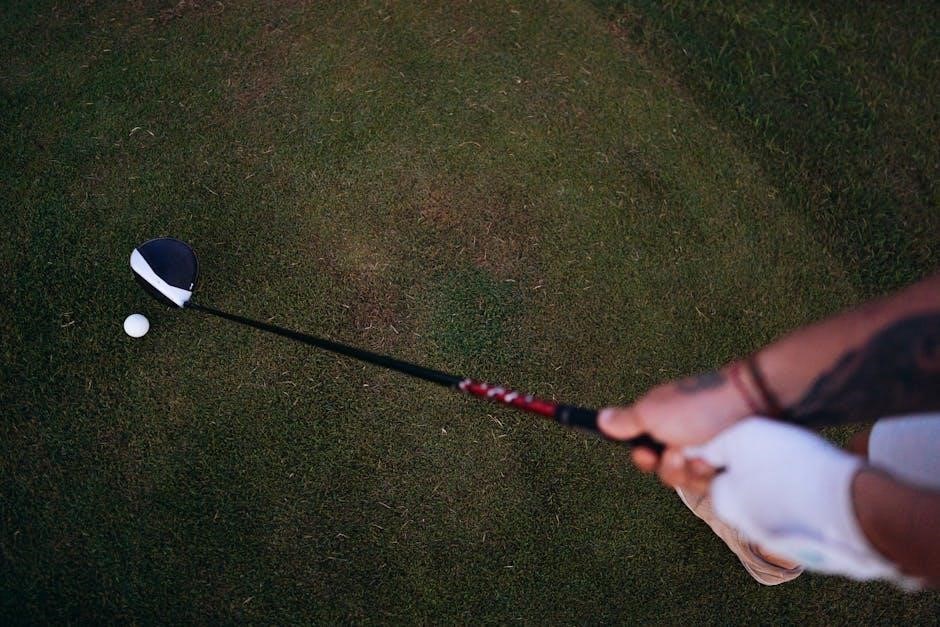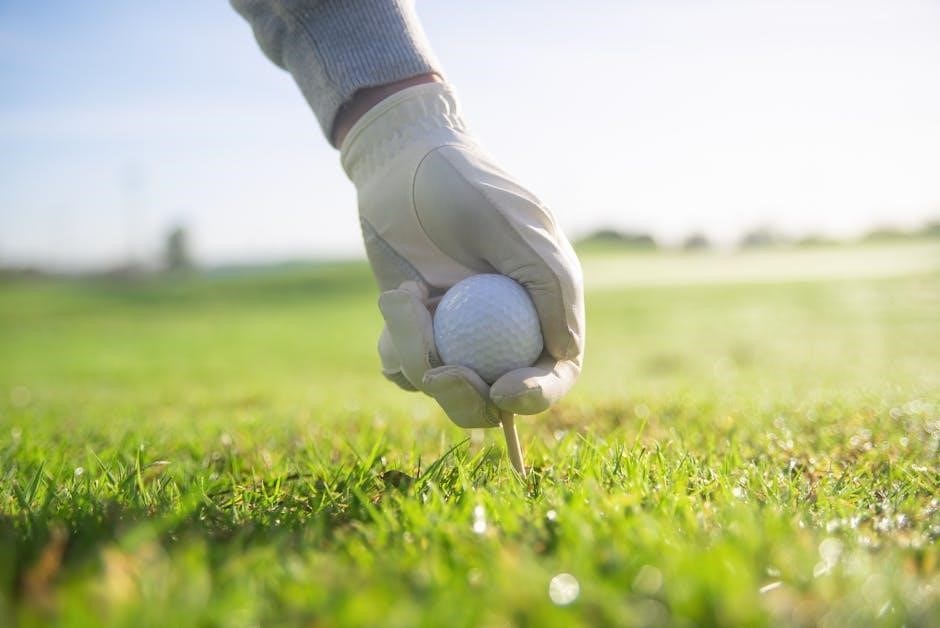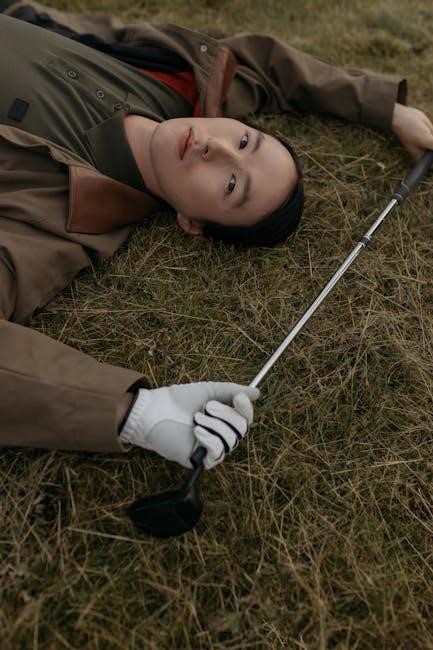A proper-fitting golf glove is essential for grip, consistency, and performance. It should fit snugly, with no wrinkles, ensuring maximum control and comfort throughout your swing.


1.1 Why Proper Fit Matters in Golf Gloves
A proper-fitting golf glove is crucial for maintaining a consistent and controlled swing; A snug fit ensures minimal hand movement during the swing, preventing misalignment and enhancing precision; If the glove is too tight, it can restrict circulation, causing discomfort and reducing sensitivity in your hands. Conversely, a glove that’s too loose may lead to inconsistent grip pressure, affecting your ability to control the clubface. A well-fitted glove also boosts confidence, allowing you to focus on your game without distractions. Proper fit directly impacts performance, making it essential to prioritize when selecting a golf glove.
1.2 The Role of Golf Gloves in Your Game
Golf gloves play a vital role in enhancing your performance on the course. They provide a secure grip on the club, reducing the risk of slippage during your swing. This consistent grip allows for better control and accuracy, especially in wet or sweaty conditions. Additionally, gloves protect your hands from blisters and abrasions caused by repeated use of the club. They also act as a barrier against extreme temperatures, keeping your hands comfortable in both hot and cold weather. A high-quality glove can improve your overall comfort and confidence, enabling you to maintain a consistent swing and focus on your game. By reducing distractions and enhancing feel, golf gloves are an essential tool for players of all skill levels.
Understanding Golf Glove Sizes
Golf gloves come in standard and cadet sizes, catering to different hand shapes and preferences. Sizes may vary slightly between brands, so trying them on is recommended.
2.1 Standard vs. Cadet Sizes
Golf gloves are available in two primary size categories: standard and cadet. Standard sizes are designed for average hand proportions, offering a balanced fit for most golfers. Cadet sizes, on the other hand, feature shorter fingers and a slightly wider palm, ideal for golfers with shorter hands or stubbier fingers. The key difference lies in finger length, with cadet gloves accommodating those who find standard gloves too long in the fingers. Both types prioritize comfort and performance, ensuring a snug fit without restricting movement. When choosing between the two, consider your hand shape and personal preference to ensure optimal grip and control during your swing.
2.2 How to Measure Your Hand for the Best Fit
To ensure the best fit, measuring your hand accurately is crucial. Start by measuring the circumference of your hand at the widest point, excluding the thumb. Use a flexible measuring tape or a string wrapped around your hand, then compare the measurement to the size chart provided by the manufacturer. Additionally, measure the length of your middle finger from the base to the tip to determine the ideal finger length for your glove. This dual measurement ensures both the palm and fingers fit properly, avoiding a glove that is too tight or too loose. Proper measurement guarantees a snug, comfortable fit, enhancing grip and control during your game.
The Importance of a Snug Fit

A snug fit is crucial for optimal performance, providing a secure grip and better control. It ensures comfort and minimizes distractions, enhancing your overall game experience.
3.1 How a Snug Fit Improves Grip and Control
A snug fit in a golf glove is vital for maintaining a firm and consistent grip on the club. When the glove fits perfectly, it minimizes the risk of the club slipping during your swing, especially on wet or sweaty hands. This secure grip allows for better control over the clubface alignment, ensuring more accurate shots. A snug fit also prevents excessive hand movement, which can disrupt your swing tempo and balance. By eliminating distractions caused by a loose glove, you can focus on your technique and maintain confidence throughout your game. Proper grip and control are foundational to consistent performance, making a snug fit an essential element of your golfing success.
3.2 The Consequences of a Poor Fit
A poorly fitting golf glove can significantly hinder your performance on the course. If the glove is too tight, it can restrict movement, causing discomfort and even affecting circulation. This can lead to a loss of feel and control, making it harder to maintain a consistent grip. Conversely, a glove that is too loose may shift during your swing, creating instability and inconsistency. Both scenarios can result in a weaker grip, potentially causing the club to slip, especially in wet conditions. Over time, an ill-fitting glove can also lead to blisters and hand fatigue, further distracting you from your game. Ultimately, a poor fit can disrupt your technique, lower your confidence, and negatively impact your overall performance, emphasizing the importance of finding the right fit for optimal results.

Key Features to Look for in a Golf Glove
When selecting a golf glove, prioritize materials that offer durability and grip, advanced moisture-wicking technology for comfort, and innovative designs that enhance performance and control.
4.1 Material Types and Their Benefits

Golf gloves are crafted from various materials, each offering unique advantages. Cabretta leather is renowned for its soft feel, durability, and ability to mold to your hand over time. Synthetic materials, such as polyurethane, provide excellent grip and are more affordable, making them ideal for beginners. Hybrid gloves combine leather and synthetic elements, offering a balance of comfort and cost-effectiveness. Moisture-wicking fabrics are incorporated into many modern designs to keep hands dry and comfortable during play. The choice of material depends on personal preference, budget, and playing conditions. High-quality materials ensure a consistent grip, enhancing performance and longevity of the glove.

4.2 Grip Technology for Enhanced Performance
Modern golf gloves feature advanced grip technologies designed to optimize performance. Traction patterns on the palm and fingers enhance grip pressure, reducing the risk of club slippage during swings. Palm pads made from textured materials provide additional stability, ensuring consistent control even in wet or sweaty conditions. Some gloves incorporate multi-material construction, blending soft, flexible zones with reinforced grip areas for precise handling. These innovations help maintain a firm yet comfortable connection with the club, allowing for smoother swings and more accurate shots. Enhanced grip technology not only boosts confidence but also contributes to better overall performance on the course. By minimizing unwanted movement, these features help golfers achieve a more consistent and reliable game.

4.3 Moisture-Wicking Fabrics for Comfort
Moisture-wicking fabrics are a crucial feature in modern golf gloves, enhancing comfort during play. These materials draw sweat away from the skin, ensuring hands stay dry and cool, even during intense rounds. Breathable mesh panels allow for airflow, preventing overheating and discomfort. Quick-drying technology helps maintain a dry grip, reducing the risk of slipping caused by moisture. By keeping hands dry and comfortable, these fabrics improve focus and consistency in every swing; They also extend the glove’s durability by reducing the effects of sweat and friction. Moisture-wicking fabrics are especially beneficial for golfers who play in warm or humid conditions, ensuring optimal performance and comfort throughout the game. This feature is a must-have for any serious golfer seeking to maintain peak performance.

Troubleshooting Common Fit Issues

Identifying and addressing fit issues ensures optimal performance. Too-tight gloves restrict circulation, while overly loose ones compromise grip. Adjustments or re-sizing may be necessary for the best results.
Wearing a glove that is too tight can hinder your performance on the course. Tight gloves restrict circulation, causing discomfort and numbness, which can affect your grip and control. Additionally, tight gloves may lead to blisters and calluses, especially during long games; It’s important to ensure there’s a little room between your skin and the glove material, especially around the fingers and palm. A snug fit is ideal, but it should never feel constricting. If you notice any tightness, consider trying a larger size or adjusting the closure system for a more comfortable fit. Proper circulation and comfort are key to maintaining consistency in your swing and overall game performance. A glove that is too loose can compromise your grip and control, leading to inconsistent swings. If your glove feels too roomy, it may cause your hand to shift during the swing, affecting accuracy. To address this, consider adjusting the closure system or trying a smaller size. Ensure the glove fits snugly without excess material, especially around the fingers and palm. Proper fit is crucial for maintaining a consistent grip pressure, which directly impacts your performance. If the glove continues to feel loose, it may be worth exploring different brands or styles, as sizing can vary between manufacturers. A well-fitting glove will stay securely in place, allowing you to focus on your game without distractions.5.1 Avoiding Gloves That Are Too Tight
5.2 Adjusting to Gloves That Are Too Loose

